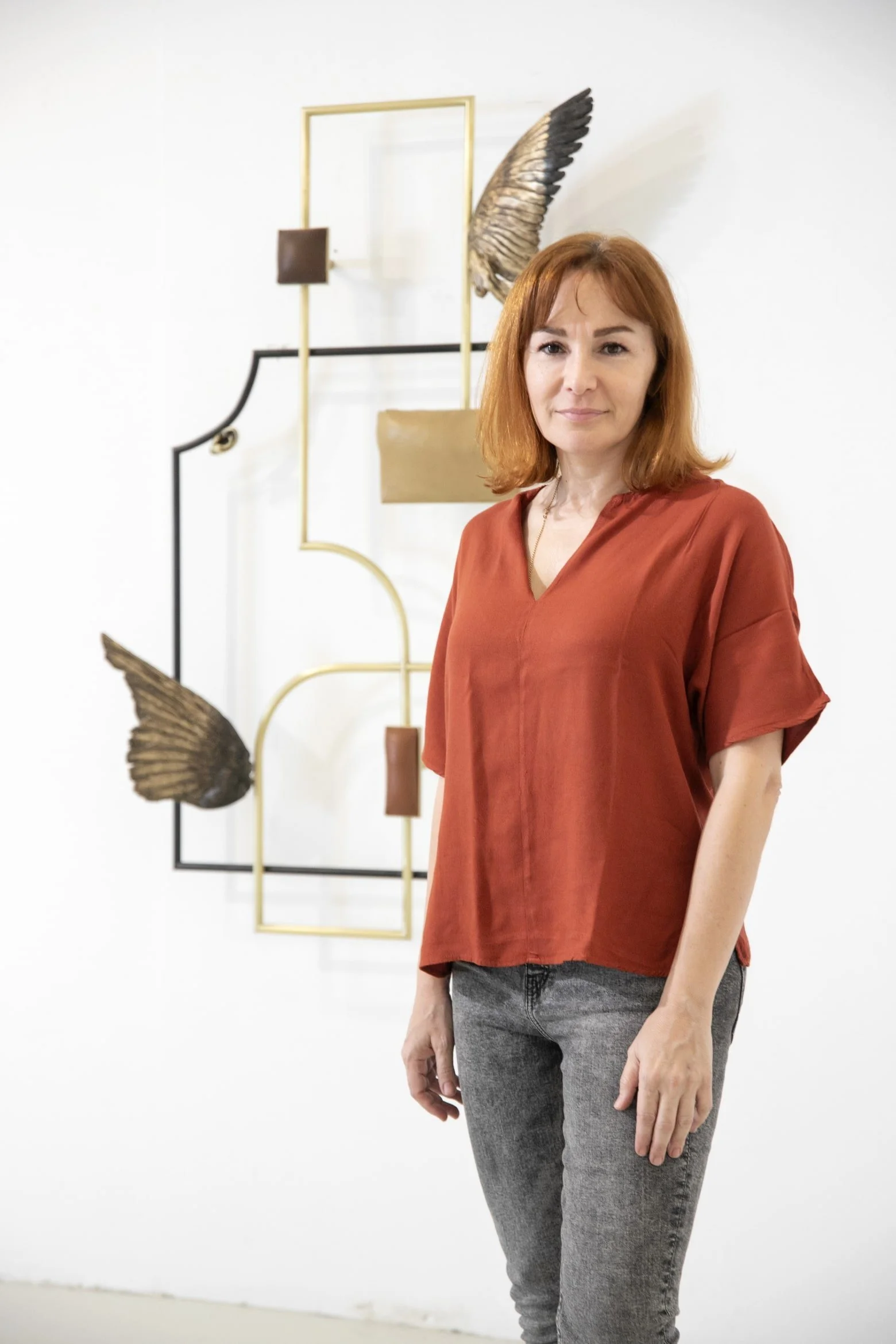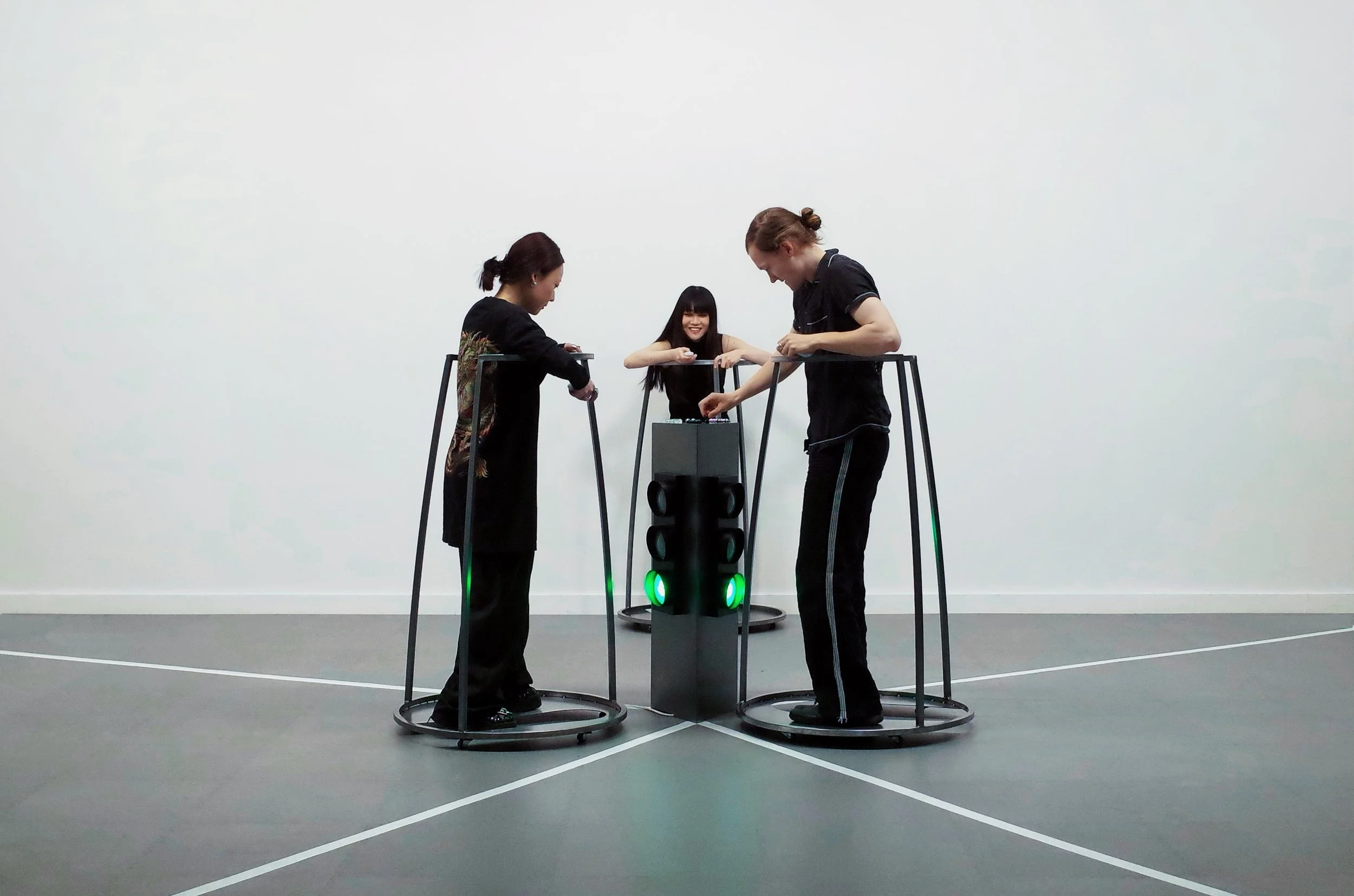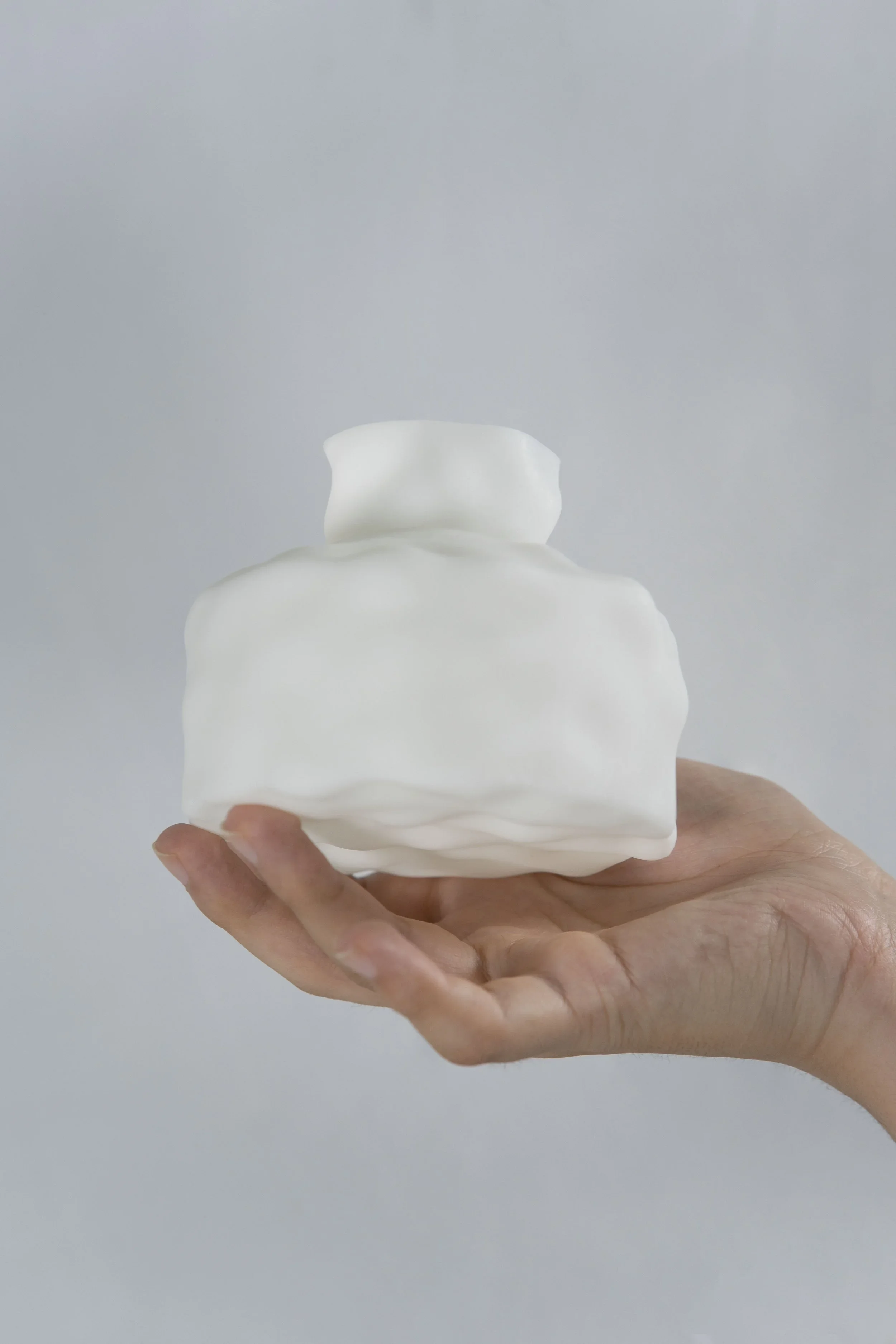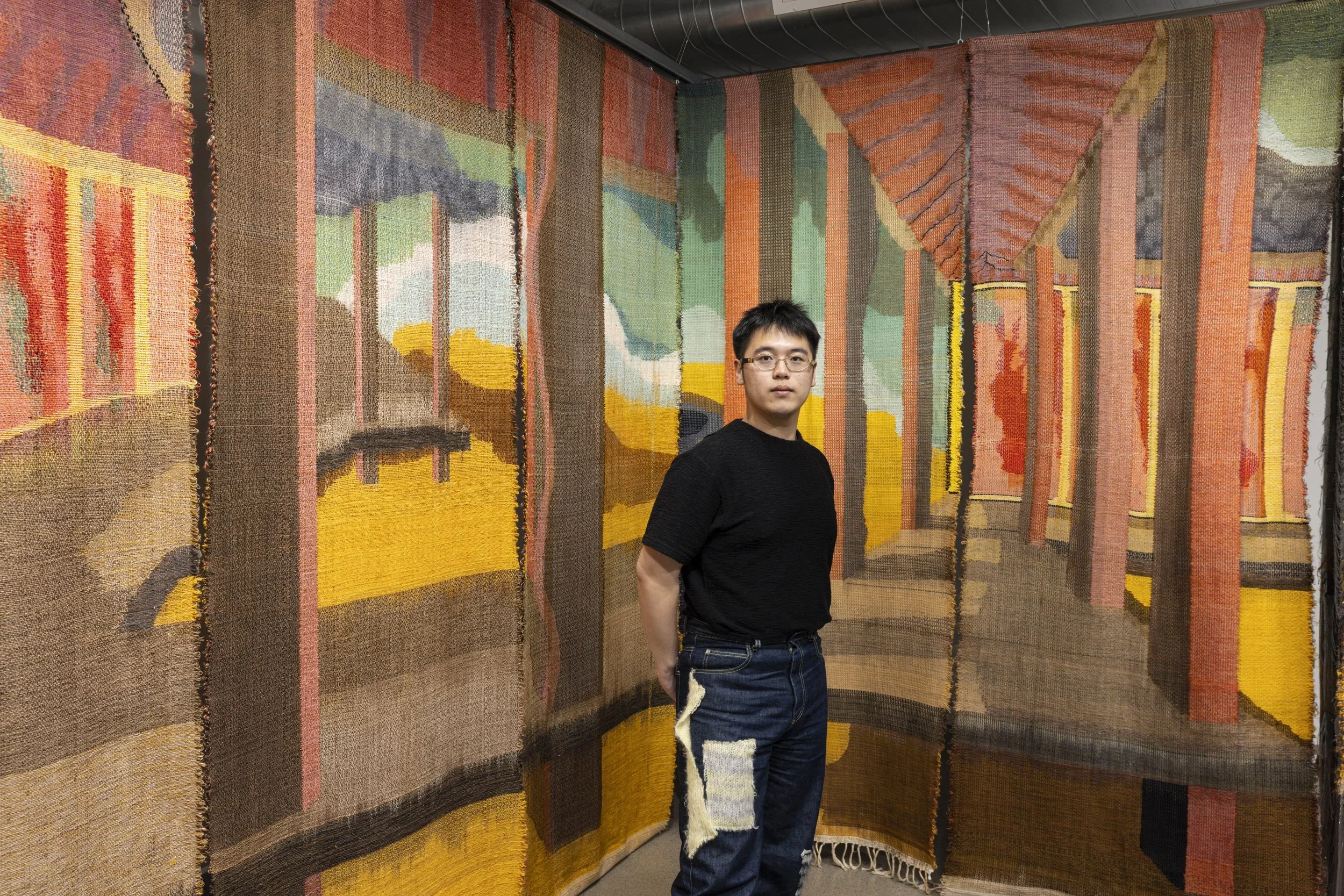10 Questions with Pavlina Vagioni
Pavlina Vagioni is a Greek multimedia artist with a kaleidoscopic practice ranging from installations to sculpting, painting, sound collages, and digital works. The common thread of her works is the contemporary exegesis and relevance of classical myths. Using a scenographic approach, she varies the size of her works, from monumental to intimate dimensions, with a combination of abstract and figurative elements.
From a background filled with diverse personal experiences, the metamorphosis of oneself in mind and spirit has always preoccupied Pavlina. The plethora of alchemical symbols, archetypes, psychological interpretations, and meanings within Hellenic mythological themes fuels her imagination and creativity. Her preference for utilizing new materials and technologies reflects her restlessness and curiosity.
Pavlina studied painting and stage design at the Athens School of Fine Arts of Greece, graduating with honors in 2016. Additionally, she is a classically trained soprano soloist with studies in piano, music theory, and composition. Her studios are in Athens, Greece, and Houston, Texas, USA, and she has been exhibiting widely. Recently, she showed her sculptures at the Byzantine & Christian Museum of Athens, Greece. Her work has also been featured in international art publications and books.
Complementary to Pavlina’s art practice is her continuous education through seminars from institutions like the Centre for Applied Jungian Studies and her knowledge of Reiki, where she holds the degree of Master – Teacher.
Pavlina Vagioni - Portrait
ARTIST STATEMENT
Pavlina Vagioni’s art is all about alchemy, re-enchanting the contemporary world through the timelessness of the myths and legends of her Hellenic heritage. Using visual and aural means, she summons mythological creatures like the Sirens, Nyx, Medusa, etc. She renders the symbols and archetypes behind them to reveal their relevance and aliveness and bridge the chasm between Cartesian rationalism and the spirituality of human beings, nature, and the cosmos.
Despite the heterogeneous character of the resulting artworks, she has a set creation method. Each new project begins by researching written source material, analyzing the etymology of words in primary sources, and interviewing knowledgeable people with original or unconventional ideas about the subject. The more diverse her sources, the more ideas she generates and the richer her ultimate interpretation. She decides on the materials based on her research. This process allows her to explore novel renditions and continuously evolve. The media also guides her toward the final work. Each medium has different properties and behavior; hence a single project is expressed through a combination of various media, which complement her chosen theme.
Get your limited edition copy now
INTERVIEW
Please, introduce yourself to our readers. What is your background, and why did you decide to be an artist in the first place?
I was born in Athens, Greece. Although my artistic inclinations had been apparent since I was little, I became an artist later in life. The reason behind this was that in most Greek families, the parents have strong opinions about their children's future. Back then, I was not assertive enough to go against my family's wishes and pursue an artistic career. It wasn't until I had accumulated sufficient and diverse life experiences that I decided to align with my nature and become a professional artist. My life path brought about my interest in the notion of metamorphosis and finding the way toward authenticity and wholeness.
Siren Topology VI, bronze, leather, plywood, tapestry filling, aluminum wire mesh, 89 x 133 x 18.5 cm, 2022 © Pavlina Vagioni
Siren Topology II, bronze, leather, plywood, tapestry filling, aluminum wire mesh, 143 x 100 x 24 cm, 2022 © Pavlina Vagioni
Siren Topology IV, bronze, leather, plywood, tapestry filling, aluminum wire mesh, 135.5 x 99 x 22 cm, 2022 © Pavlina Vagioni
What is your aim as an artist?
To connect. I feel my work will always remain incomplete unless there is a viewer to see it and experience it. Moreover, I can establish a more genuine connection with others through art. There is less resistance to images and sound when attempting to reach the deeper layers of someone's psyche.
You work with several mediums, from installations to sculpting and painting to sound collages and digital works. How would you define yourself as an artist? And how did this definition change over the years?
I am a multimedia artist. However, this definition is not entirely precise because I am also a musician. My studies in classical singing, music theory, and composition are double in length of those in the visual arts. Although my degree was in painting, I also studied drawing, ceramics, and stage design at the Athens School of Fine Arts. As the years of my practice add up, the more multidisciplinary my work is becoming.
Anthemoessa, leather, galvanized sheet metal, plyboard, MDF board, acrylic mirror, motors, 3D printed ABS filament, oil, oil pastel, encaustic wax, 200 x 213 x 142 cm, 2021 © Pavlina Vagioni
Speaking of mediums, what is your preferred one? The one you feel closer to your practice? On the contrary, the one you find more challenging?
I like using my hands and body. All painting, drawing, and sculpting mediums feel closer to my practice. The digital material, however, is more challenging because it is more cerebral and less physical. But the most challenging aspect of my practice is creating large multimedia installations because I have technical difficulties to overcome on top of the aesthetic ones. I have to think like both an artist and an inventor. But I like getting outside my comfort zone and continuously evolving my practice.
What is the main idea behind your work, and what message were you trying to convey?
To reveal. Reveal the mystery within ourselves. To bring into consciousness what lies in the subconscious. Our contemporary world is very rational, pragmatic, and, in a sense, desacralized. I am not referring to religion here. I am talking about spirituality. If we understand our spiritual connection to nature, animals, and in a greater context, the cosmos, we will feel less alienated and more complete. My work is about finding and revealing the magical and wondrous in our lives.
Isle of the Sirens, styrofoam, polyurethane foam, acrylic resin, fiberglass, acrylic paint, graphite powder varnish, wood, plexiglass, video projection, speakers, 250 x 400 x 400 cm, 2022 © Pavlina Vagioni
We know all things that come to pass upon the fruitful earth, marine grade plywood, motor, sheet metal, iron frame, resin, LED lighting, plexiglass, oil, acrylic, cables 134 x 240 x 145 cm, 2022 © Pavlina Vagioni
In your statement, as inspiration for your work, you quote "alchemical symbols, archetypes and psychological interpretations and meanings within Hellenic mythological themes." Can you tell us more about it?
There is wisdom behind the origin of words. "Mythology," in Greek, comes from the root myo. The terms mystic, mystery, and secret (mystiko) are derivatives of this root. It means something sealed, enclosed. In a metaphorical sense, it is about closing our mouths, eyes, and ears and remaining in a world of silent darkness. Then comes the root logos (logic, analogy, expression) to reveal what is inside this mysterious place. But this "language" communicates with us through symbols. Every mythological theme is understood by our non-rational and subconscious parts. Since we all have different desires and hidden truths, this means that each one of us will react differently to these stories. Consequently, a single theme will bring about diverse emotional responses.
What do you see as the strengths of your work, both visually and conceptually?
I am both a visual artist and a musician, so I combine visual and musical thought when I create. Also, I like complexity. I prefer to choose and combine various media when materializing an idea, like sound, image, movement, text, etc. This diversity increases the possibility of establishing a connection with the viewer through the work in either a sensory, emotional, or even intellectual manner.
You already have a long and successful career; how do you promote your work?
I promote it by applying to open calls like yours and learning to have a solid digital presence. In this way, I can increase the visibility of my work, regardless of the geographical location of the studio.
Come hither, as thou fairest, oil, oil pastel, encaustic wax on plywood and electrostatic paint on bronze, variable dimensions, 2021-2022 © Pavlina Vagioni
What do you think of Crypto art? The Crypto market has had a significant crash since the end of the pandemic. Do you think this is the beginning of the end for NFTs?
On the contrary, I think they are here to stay. Our world is becoming increasingly digital, so Crypto art seems very promising. The crash you are referring to is merely a market correction because the framework is still in its early stages. Don't forget that before this crash, we observed extreme sale records which did not necessarily coincide with the artistic value of the NFTs. Crypto art prices will stabilize in the future as the market matures.
And finally, what are you working on now? Do you have any new projects or series you are working on?
To follow up on the Crypto art, I launched some digital artworks through PINSL, a newly founded German platform specializing in Fine Art NFTs and collaborations with visual artists and galleries only. Additionally, I am researching Medusa and the mythic sea-god Proteus. I am curious to see the new artistic paths this research will take me.

























